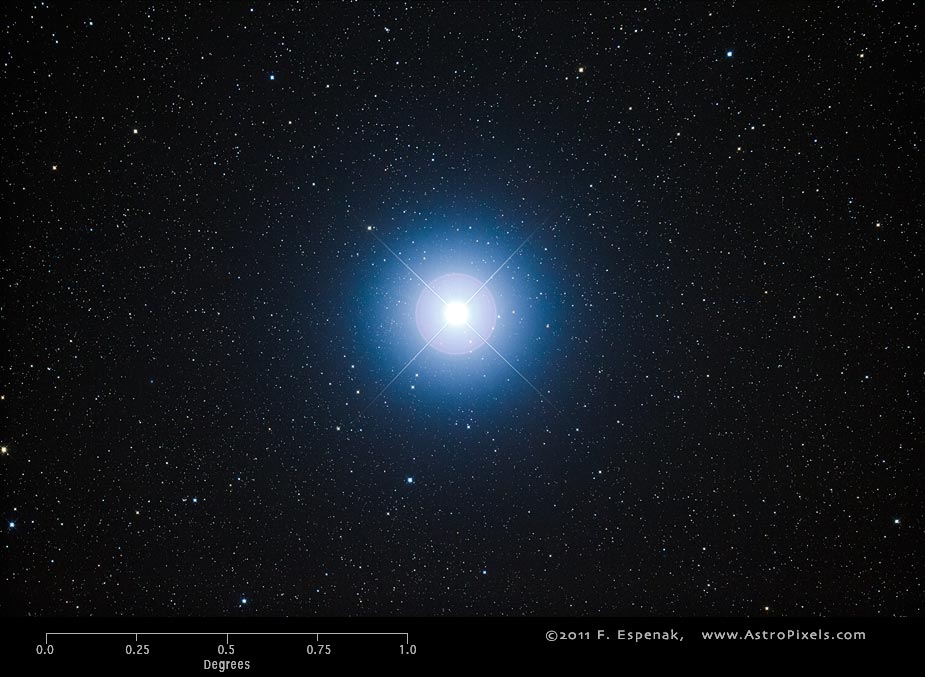Sirius
Sirius or Alpha Canis Majoris (Alp CMa) is the brightest naked eye star in the constellation Canis Major. With an apparent magnitude of -1.44, Sirius is the 1st brightest star in the entire sky (see: 50 Brightest Stars ). Its absolute magnitude is 1.45 and its distance is 8.6 light years.The Equinox J2000 equatorial coordinates are RA = 06h 45m 08.9s, Dec = -16° 42' 58".
Sirius has a spectral type of A1V, a surface temperature of 9940° Kelvin and a luminosity 25 times the Sun. It has a mass of 2.02 solar masses and a diameter 1.7 times the Sun.
The image above shows the uncropped view of Sirius (North is up) through the Takahashi E-180 Astrograph.
Sirius is actually a binary star system, consisting of a white main sequence star called Sirius A (spectral type A1V), and a faint white dwarf companion (spectral type DA2), termed Sirius B. The distance separating Sirius A from its companion varies between 8.1 and 31.5 Astronomical Units.
Sirius appears bright because of both its intrinsic luminosity and its proximity to Earth. At a distance of 8.6 light years (2.6 parsecs), the Sirius system is one of Earth's near neighbors; for Northern-hemisphere observers between 30 degrees and 73 degrees of latitude (including almost all of Europe and North America), it is the closest star visible to the naked eye. Although Sirius A is about 25 times more luminous than the Sun, it has a significantly lower luminosity than other bright stars such as Canopus, Deneb or Rigel.
the Sirius system is between 200 and 300 million years old. It was originally composed of two bright bluish stars. The more massive of these, Sirius B, consumed its resources and became a red giant before shedding its outer layers and collapsing into its current state as a white dwarf around 120 million years ago.
Sirius is known colloquially as the "Dog Star", reflecting its prominence in Canis Major (Greater Dog). The heliacal rising of Sirius marked the flooding of the Nile in Ancient Egypt and the "dog days" of summer for the ancient Greeks. The name Sirius is derived from the Ancient Greek for "glowing" or "scorcher").
The description above is based on the Sirius entry in Wikipedia.For more information about Sirius, see Stars (Jim Kaler).
Technical Details
- Object: Sirius
- Other Names: Alpha Canis Majoris, HR2491, HD48915, HIP32349
- Object Type: bright star
- Object Data: Apparent Magnitude = -1.44, Absolute Magnitude = 1.45, distance = 8.6 light years
- Object Position (Equinox J2000): RA = 06h 45m 08.9s, Dec = -16° 42' 58", Constellation = Canis Major
- Date/Time: 2011 Mar 30 at 03:18:19 UTC
- Location: Bifrost Astronomical Observatory, Portal, AZ
- Mount: Astro-Physics 1200GTO
- Telescope: Takahashi Epsilon 180 Hyperbolic Astrograph
- Camera: Canon EOS 550D (Rebel T2i) (modified with a Baader UV/IR filter)
- Field of View: 1.70° x 2.56° at 1.7 arc-sec/pixel (web version: 10.0 arc-sec/pixel)
- Exposure: 2 x 300s, f/2.8, ISO 800
- File Name: Sirius-01w.jpg
- Processing (Adobe Camera Raw): Graduated Filter, Vignetting Correction, Noise Reduction, White Balance, Curves
- Processing (Photoshop CS5): Average Images, Curves, Noise Reduction
- Original Image Size: 3454 × 5179 pixels (17.9 MP); 11.5" x 17.3" @ 300 dpi
- Rights: Copyright 2011 by Fred Espenak. All Rights Reserved. See: Image Licensing.
